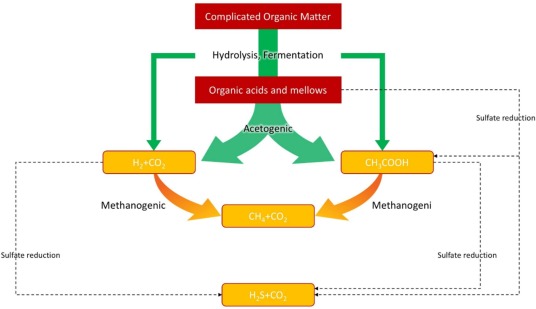BIOGAS - Introduction
Biogas is produced after organic materials (plant and animal products) are broken down by bacteria in an oxygen-free environment, a process called anaerobic digestion. Biogas systems use anaerobic digestion to recycle these organic materials, turning them into biogas, which contains both energy (gas), and valuable soil products (liquids and solids).
Biogas is a colorless combustible gas that is produced by the biological breakdown of organic matter; occurring in the absence of oxygen. The biogas comes from “biogenic materials” and it is generated from AD of biodegradable materials such as biomass, cow dung green waste and agricultural residue such as cassava, sugar cane etc. . Biogas comprises a mixture of different gases, mainly methane (CH4), carbon dioxide (CO2), 1–5 % other gases, including hydrogen (H2). The gas is produced by bacteria that occur during the bio-degradation of organic materials under anaerobic conditions . The energy that is released from biogas makes it a suitable fuel in any country for heating and cooking purpose. Biogas can also be used in an anaerobic digester where the energy in the gas is converted into electricity and heat using gas engine
How to produce biogas


Sources of biogas production
- •Wastes and residues of agriculture and related industries.
- •Municipal solid waste.
- •Municipal wastewater.
- •Animal excrement.
- •Industrial solid and liquid wastes and wastes (industrial sludge).
Sources of biogas production
- •Wastes and residues of agriculture and related industries.
- •Municipal solid waste.
- •Municipal wastewater.
- •Animal excrement.
- •Industrial solid and liquid wastes and wastes (industrial sludge).
Different processes of converting biomass into biogas
| Zero phase (Input) | First phase (Hydrolysis) | Second phase (Acidification) | Third phase (Acidification) | Fourth phase (Methanogenesis) |
|---|---|---|---|---|
| Carbohydrates | sugars | Carbonic acid | Acetic acid | methane |
| Carbohydrates | sugars | Carbonic acid | Acetic acid | methane |
| fats | Fatty acids | Alcohols | hydrogen | Carbon dioxide |
| proteins | Amino acids | Carbon dioxide | Carbon dioxide | Carbon dioxide |

Conclusion
Biogas systems turn the cost of waste management into a revenue opportunity for America’s farms, dairies, and industries. Converting waste into electricity, heat, or vehicle fuel provides a renewable source of energy that can reduce dependence on foreign oil imports, reduce greenhouse gas emissions, improve environmental quality, and increase local jobs. Biogas systems also provide an opportunity to recycle nutrients in the food supply, reducing the need for both petrochemical and mined fertilizers.
Biogas systems are a waste management solution that solve multiple problems and create multiple benefits, including revenue streams. The United States currently has the potential to add 13,500 new biogas systems, providing over 335,000 construction jobs and 23,000 permanent jobs. However, to reach its full potential, the industry needs consistent policy support. Reliable funding of Farm Bill energy title programs and a strong Renewable Fuel Standard encourage investment and innovation in the biogas industry. If the United States intends to diversify its fuel supply and take action against climate change, it should strongly consider the many benefits of biogas.